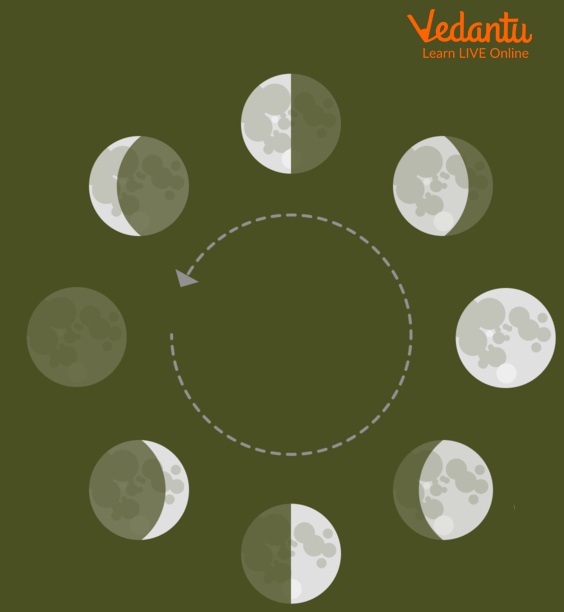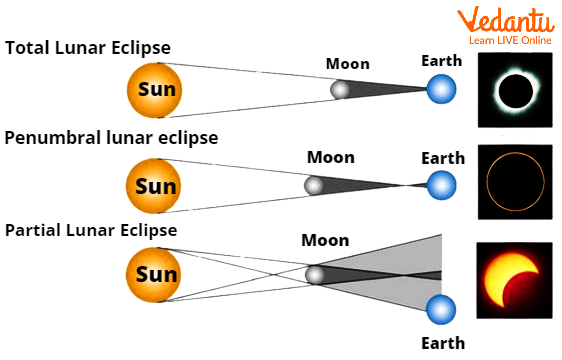




How Does a Lunar Eclipse Occur?
A lunar eclipse is one of the most incredible attractions the night-time sky has to offer. As the Moon slides into Earth's shadow, the typically faded white moon is painted a deep colour of red, and it can continue to be that way for a long time. Lunar eclipses can be either partial or total, simply as solar eclipses are, and they solely appear at some stage in one segment of the moon: the full Moon.
What Is the Lunar Eclipse?
The lunar eclipse of the Moon is caused by Earth which completely blocks the direct Sun rays which reach the Moon, with the only light reflected from the lunar surface being refracted by Earth's atmosphere. This light appears reddish for the same reason that a sunset or sunrise does, which is explained by the Rayleigh scattering of blue light. Unlike a solar eclipse, which can only be seen from an exceptionally small place of the world, a lunar eclipse might also be considered from somewhere on the night time aspect of Earth.
The time of a lunar eclipse can last up to almost two hours, while a complete solar eclipse lasts only up to a few minutes at any given place, due to the fact the Moon's shadow is smaller. Also, in contrast to solar eclipses, lunar eclipses are safer to view without any eye safety or specific precautions as they are dimmer than the full Moon.
What happens in a lunar eclipse? During a complete lunar eclipse, the lunar surface turns a rusty red colour, earning the nickname "blood moon".

Phases of Moon
Types of Lunar Eclipse
Earth's shadow can be divided into two special parts: the umbra and penumbra. The Earth completely stops direct solar radiation inside the umbra, the central area of the shadow. However, considering that the Sun's diametre seems about one-quarter of Earth's in the lunar sky, the planet only partially blocks direct daylight inside the penumbra, the outer element of the shadow.
There are two types of Lunar Eclipse. They are listed below:
Total Lunar Eclipse
Partial Lunar Eclipse
The Earth absorbs direct solar rays within the umbra and the central region of the shadow. However, since the diameter of the Sun occurs about one-fourth of Earth's in the Lunar calendar, the Earth partially blocks direct Sun rays within the penumbra whereas the outer portion of the shadow.

Lunar Eclipses
What is the Total Lunar Eclipse?
A total lunar eclipse happens when the Moon and Sun are on the opposite faces of the Earth. This happens when the Moon falls totally inside the Earth's umbra. This is when the Moon passes into Earth's umbral shadow, which may lead to the Moon turning red. The second the Moon enters a whole eclipse, the complete floor will come to be greater or much less uniformly bright.
What is a Partial Lunar Eclipse?
A partial lunar eclipse happens when the Earth moves between the Sun and Moon; however, the 3 celestial bodies don't form a line in space. When that happens, a little part of the Moon's surface is covered by the darkest, central part of the Earth's shadow, known as the umbra. The rest of the Moon is covered by the outer part of the Earth's shadow known as the penumbra.
Stages of a Partial Lunar Eclipse
Penumbral Eclipse Begins: The Earth's penumbra starts covering the Moon's surface.
Partial Eclipse Begins: The Earth's shadow starts moving over the Moon.
Maximum Eclipse: The Earth's umbra covers the biggest part of the Moon.
Partial Eclipse Ends: The Earth's umbra does not cover the Moon.
Penumbral Eclipse Ends: The Earth no longer casts a shadow on the Moon.
Total Lunar Eclipse Blood Moon
Certain lunar eclipses are stated as "blood moons" in notable articles; however, this is often no longer a scientifically recognised term. The Moon turns red throughout an eclipse because of how the Sun's rays interact with Earth's atmosphere. Since it hits the atmosphere, shorter wavelengths of light like the colour blue are scattered outwards. Longer wavelengths like red, however, are bent or refracted into Earth's umbra. Once these strike the surface of the Moon, they can make it appear red - the same process to how the sky seems red during a sunrise or sunset.
Difference Between Solar and Lunar Eclipse
The differences between the solar eclipse and lunar eclipse are listed in the following table.
Important Questions
1. The Moon orbits the Earth in _____.
27.32 days
27.53 days
33.33 days
53.06 days
Answer: a) 27.32 days
Explanation: The Moon takes 27.32 days to go around the Earth.
2. How is the lunar eclipse classified?
Answer: The lunar eclipse is classified into a total lunar eclipse, partial lunar eclipse, and penumbral lunar eclipse.
3. How many solar eclipses can be seen in a year?
Answer: Solar eclipses occur twice to five times a year.
Conclusion
Lunar eclipses are more simply observed than solar eclipses, as they'll be viewed with the unaided eye by any observer located where the Moon is above the horizon. A lunar eclipse is caused by Earth blocking daylight from reaching the Moon and creating a shadow across the lunar surface. The sun-blocking Earth forms 2 shawods that fall on the Moon throughout a lunar eclipse: the umbra could be a full, dark shadow, and the penumbra could be a partial outer shadow.
FAQs on Lunar Eclipse: Concepts, Phases & Significance
1. What is a lunar eclipse and during which lunar phase does it occur?
A lunar eclipse is a celestial event that happens when the Moon passes directly behind the Earth and into its shadow. This can only occur when the Sun, Earth, and Moon are exactly or very closely aligned, with the Earth positioned between the other two. A lunar eclipse always happens during the Full Moon phase, as this is the only time the Moon is opposite the Sun in the sky.
2. What is the specific alignment of the Sun, Earth, and Moon during a lunar eclipse?
During a lunar eclipse, the three celestial bodies are in an alignment known as 'syzygy'. The correct order is Sun, Earth, and then Moon. The Earth blocks the direct sunlight from reaching the Moon, casting a shadow on its surface. This alignment is the reason a lunar eclipse can only happen on a Full Moon night.
3. Why doesn't a lunar eclipse happen during every Full Moon?
A lunar eclipse does not occur every month during the Full Moon because the Moon's orbit around the Earth is tilted by about 5 degrees relative to Earth's orbit around the Sun. Because of this tilt, the Moon usually passes either above or below Earth's shadow during its full phase. An eclipse only happens when the Full Moon crosses the plane of Earth's orbit at the precise time it is aligned with the Sun and Earth.
4. What are the main types of lunar eclipses?
There are three main types of lunar eclipses, determined by how much of the Moon enters Earth's shadow:
- Total Lunar Eclipse: The entire Moon passes through the darkest part of Earth's shadow, the umbra. During this phase, the Moon can appear reddish.
- Partial Lunar Eclipse: Only a part of the Moon passes through the umbra, while the rest remains in the lighter shadow, the penumbra.
- Penumbral Lunar Eclipse: The Moon passes only through Earth's faint, outer shadow, the penumbra. This type is subtle and often difficult to observe as the Moon's dimming is very slight.
5. What is the difference between Earth's umbra and penumbra shadows?
Earth's shadow has two distinct parts that cause different types of eclipses:
- The umbra is the inner, darker part of the shadow. If you were on the Moon inside the umbra, the Earth would completely block your view of the Sun. This is where a total or partial lunar eclipse occurs.
- The penumbra is the outer, fainter part of the shadow. From the Moon's surface within the penumbra, the Earth would only partially block the Sun. This region causes the very subtle penumbral eclipse.
6. Why does the Moon often look red during a total lunar eclipse?
The Moon appears reddish during a total lunar eclipse due to a phenomenon called Rayleigh scattering. While the Earth blocks direct sunlight, some light still passes through Earth's atmosphere and is bent or refracted toward the Moon. The atmosphere scatters away most of the blue-colored light but allows the red and orange light to pass through. This reddish light illuminates the Moon, giving it a coppery glow, sometimes called a 'Blood Moon'.
7. What is the main difference between a lunar eclipse and a solar eclipse?
The main difference lies in the alignment and which body is being obscured. In a lunar eclipse, the Earth is between the Sun and Moon (Sun-Earth-Moon), casting a shadow on the Moon. In a solar eclipse, the Moon is between the Sun and Earth (Sun-Moon-Earth), casting a shadow on the Earth and blocking the view of the Sun from a small part of our planet.
8. Is it necessary to use special equipment to watch a lunar eclipse?
No, it is perfectly safe to watch a lunar eclipse with your naked eyes. Unlike a solar eclipse, a lunar eclipse does not involve looking at the Sun. The Moon is only reflecting faint, indirect sunlight and is never brighter than a regular Full Moon. Using binoculars or a small telescope can, however, enhance the view and make the colour and details on the Moon's surface more visible.
9. What are the eight primary phases of the Moon?
The eight primary phases of the Moon, in order, describe how much of the sunlit side of the Moon is visible from Earth. The cycle is as follows:
- New Moon
- Waxing Crescent
- First Quarter
- Waxing Gibbous
- Full Moon
- Waning Gibbous
- Third Quarter
- Waning Crescent
After the Waning Crescent, the cycle returns to the New Moon.
10. How long does a typical lunar eclipse last?
The duration of a lunar eclipse can vary significantly. A total lunar eclipse can last for a few hours from start to finish. The period of totality, when the Moon is completely inside Earth's umbra, typically lasts from about 30 minutes to over an hour. The entire event, including the partial and penumbral phases, can span 3 to 4 hours.





















